
The safe-haven Japanese yen rallied on Wednesday while riskier currencies like the Australian dollar and sterling languished as traders ran for cover following the worst sell-off in almost a month on Wall Street.
The catalyst was ostensibly some soft U.S. manufacturing data, which fanned worries about a hard landing for the world's biggest economy, with traders already nervous ahead of crucial monthly payrolls data on Friday.
"Price action across global markets (is) exhibiting the hallmarks of an unfolding growth scare," said Kyle Rodda, senior financial market analyst at Capital.com.
"The most damning price signals were in FX and commodity markets," Rodda added, singling out the yen and Aussie, highlighting a nearly 5% overnight slump for crude oil.
The yen was about 0.3% stronger at 145.02 per dollar as of 0047 GMT, following a 1% rally overnight against a broadly stronger dollar.
The dollar-yen pair tends to track long-term U.S. Treasury yields, which dropped nearly 7 basis points (bps) overnight and continued to decline in Asian hours to stand at 3.8329%, with investors flocking to the safety of bonds.
The dollar, though, was firm against most other major peers, as it tends to draw safety flows even when the U.S. economy is the locus of concern.
Sterling edged down to $1.3110, after weakening 0.23% overnight. The euro rose slightly to $1.10495, following a 0.26% decline in the previous session.
The Aussie slipped a further 0.15% to $0.67015, extending Tuesday's 1.2% tumble.
Risks to the U.S. soft-landing scenario – which had been gaining traction recently in markets – saw traders raise odds of a 50 basis point (bp) Federal Reserve interest rate cut on Sept. 18 to 38% from 30% a day earlier, according to the CME Group's FedWatch Tool.
"Markets are nervous ahead of Friday's very important non-farm payroll report, … which most market participants acknowledge will be a significant factor at the very least in whether the Fed cuts by 25 or 50," said Gavin Friend, senior markets strategist at National Australia Bank.
"All those asset moves point to a risk-off view and a bias for safe havens, (with investors) stepping back a bit."
Economists surveyed by Reuters expect Friday's report to show an increase of 165,000 U.S. jobs in August, up from a rise of 114,000 in July.
Ahead of that, investors will keep a close eye on job openings data on Wednesday and the jobless claims report on Thursday.
U.S. markets had been closed for the Labor Day holiday on Monday and came back Tuesday to a weak Institute for Supply Management (ISM) survey that suggested factory activity in the country would remain subdued for a while.
"That was supposed to show a gain, but actually showed a decline, and has made people wonder once more about the Fed possibly being too late to act," said Sam Stovall, chief investment strategist at CFRA.
"This may be a short week but it will be an important and crucial one for investor confidence," he added. "People are going to remain on edge."
